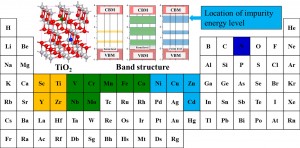Jinlong Gong and co-workers provide novel insights into TiO2 co-doping for photocatalytic applications in their recent PCCP paper.

The group investigated the general trend of electronic properties of anatase TiO2 photocatalysts co-doped with transition metals and nitrogen using first-principles density functional theory. They found that the absorption edges of TiO2 are shifted to the visible-light region upon introduction of dopants, due to the reduced conduction band minimum and the formation of impurity energy levels in the band gap. They propose that co-doping systems such as (V, N), (Cr, N), and (Mn, N), which have impurity energy levels with significant bandwidths, are the most promising candidates for photovoltaic applications in the visible light range.
Read this HOT article today:
Understanding Electronic and Optical Properties of Anatase TiO2 Photocatalysts co-doped with Nitrogen and Transition Metals
Qingsen Meng, Tuo Wang, Enzuo Liu, Xinbin Ma, Qingfeng Ge and Jinlong Gong
DOI: 10.1039/C3CP51476E










